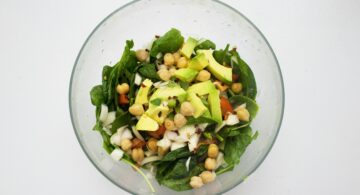Metabolic Syndrome: A Recipe for Disaster
It’s a recipe that no one chooses; yet so many people have all the right ingredients. Metabolic syndrome is a collection of risk factors that, when combined, have the potential for deadly consequences. Plainly put, if you have metabolic syndrome, you are twice as likely to have a heart attack or stroke!
Below is the list of conditions that can make up metabolic syndrome:
- Central or abdominal obesity (measuredby waist circumference):
- Men – 40 inches or above
- Women – 35 inches or above
- Triglycerides greater than or equal to 150 milligrams per deciliter of blood
- HDL cholesterol:
- Men – Less than 40 mg/dL
- Women – Less than 50 mg/dL
- Blood pressure greater than or equal to 130/85
- Fasting glucose greater than or equal to 100
Having 3 or more of these conditions constitutes metabolic syndrome. Together, they greatly increase your risk for:
- Heart disease
- Stroke
- Even diabetes
However, you can avoid these conditions by following a proper diet. Dramatically reducing your risk for these top three health problems can be as simple as changing what you eat.
Breaking Down the Big Mac
With today’s modern diet, it’s no wonder that more than 1 in 3 Americans have metabolic syndrome! Having this deadly combination of risk factors was far less common 30-40 years ago.Processed and fast foods now dominate the food market. Health has taken a back seat to convenience in this shift in food culture. Buying pre-cooked meals from a drive-thru is far more convenient than going home to cook meals from scratch. These meals may seem inexpensive, but they truly come with a price. And that price can be the loss of your health or even your life!
Have you ever taken the time to read the ingredient list for the fast foods you eat? What about the boxed or canned items you pick up at the grocery store? Most people look at the calories or fat content, but don’t take the time to read any further to find out what the actual ingredients are.
I’ve probably said it hundreds of times by now, but it’s worth repeating. One of the easiest ways to transition to a healthy diet is to follow the rule: “If you can’t pronounce it, then don’t eat it.”
Fast foods and other processed foods are packed full of ingredients that aren’t food at all! The artificial flavorings, preservatives, and artificial colors masked as ingredients are not fit for human consumption.
Each artificial food additive has the potential to cause metabolic syndrome. The toxins in artificial ingredients encourage unnatural processes in the body, which lead to:
- Obesity
- Diabetes
- High cholesterol
- And much more
All together, a packaged food product creates a package for chronic disease. Click to Tweet.
Just to get an idea of the plethora of artificial ingredients contained in fast foods, let’s take a look at the ingredients in a Big Mac.
The Bun
McDonald’s Big Mac Bun Ingredients:
Enriched Flour (Bleached Wheat Flour, Malted Barley Flour, Niacin, Reduced Iron, Thiamin Mononitrate, Riboflavin, Folic Acid), Water, High Fructose Corn Syrup and/or Sugar, Yeast, Soybean Oil and/or Canola Oil, Contains 2% or Less: Salt, Wheat Gluten, Calcium Sulfate, Calcium Carbonate, Ammonium Sulfate, Ammonium Chloride, Dough Conditioners (May Contain One or More of: Sodium Stearoyl Lactylate, DATEM, Ascorbic Acid, Azodicarbonamide, Mono and Diglycerides, Ethoxylated Monoglycerides, Monocalcium Phosphate, Enzymes, Guar Gum, Calcium Peroxide), Sorbic Acid, Calcium Propionate and/or Sodium Propionate (Preservatives), Soy Lecithin, Sesame Seed.
I’m not sure about you, but I struggle to pronounce at least half of the bun’s ingredients. If this seems to be an unnecessarily long list of ingredients for a couple of pieces of bread, then you’re right! I can hardly refer to many of these ingredients as “food” as they are far from natural or providing your body with any form of nutrition.
Bread should only consist of about 4 or 5 ingredients. Instead, these buns have over 20 ingredients! The added chemicals condition the dough and more importantly preserve the buns so they can sit on the shelves for months at a time. Some of the most dangerous ingredients include:
- High Fructose Corn Syrup: Causes metabolic disturbances that can lead to obesity, high triglycerides, diabetes, cancer and more!
- Soybean Oil/Canola Oil: Increases cholesterol, hormone disturbances, and auto-immune disorders http://www.ncbi.nlm.nih.gov/pubmed/18648182
- Mono and Diglycerides and Ethoxylated Monoglycerides: These are technically trans-fats, although the government doesn’t require that they be labeled as such. Trans-fats raise bad LDL cholesterol, lower the good HDL cholesterol and raise triglycerides.
- Azodicarbonamide: This ingredient is also found in yoga mats and other rubber and plastic products. It is a delicious (note the sarcasm) bleaching agent and a known carcinogen. It can also cause respiratory issues, immunity decline, and lowered hormone production.
High fructose corn syrup and canola oil sound tempting? Those ingredients are two of the best serial killers in the world! They get away with murder, causing an epidemic of obesity and seeing a nation struggling with heart disease and diabetes. So why do they put it in? Because it’s addictive and makes your body crave more!
The Cheese
McDonald’s Big Mac Cheese Ingredients:
Milk, Cream, Water, Cheese Culture, Sodium Citrate, Contains 2% or Less of: Salt, Citric Acid, Sodium Phosphate, Sorbic Acid (Preservative), Lactic Acid, Acetic Acid, Enzymes, Sodium Pyrophosphate, Natural Flavor (Dairy Source), Color Added, Soy Lecithin (Added for Slice Separation).
Though not near as lengthy as the bun, the cheese still contains preservatives and unnecessary ingredients that don’t belong in the human body. The advantage of this processed cheese is longer shelf life and product uniformity. These features make such products convenient for the consumer, but the presence of artificial ingredients introduces certain health risks, like damage to the kidneys.
The substitutes used for making natural cheese are artificial and may trigger allergic reactions and cause diarrhea. The added color has been shown to promote tumor growth in the adrenal glands and kidneys in animal studies.
The Sauce
McDonald’s Big Mac Sauce Ingredients:
Soybean Oil, Pickle Relish (Diced Pickles, High Fructose Corn Syrup, Sugar, Vinegar, Corn Syrup, Salt, Calcium Chloride, Xanthan Gum, Potassium Sorbate [Preservative], Spice Extractives, Polysorbate 80), Distilled Vinegar, Water, Egg Yolks, High Fructose Corn Syrup, Onion Powder, Mustard Seed, Salt, Spices, Propylene Glycol Alginate, Sodium Benzoate (Preservative), Mustard Bran, Sugar, Garlic Powder, Vegetable Protein (Hydrolyzed Corn, Soy and Wheat), Caramel Color, Extractives of Paprika, Soy Lecithin, Turmeric (Color), Calcium Disodium EDTA (Protect Flavor).
If you look closely, you can spot a few “real” ingredients intermixed with the many chemicals that make up the Big Mac Sauce. However, the bulk of the “special sauce” isn’t that special at all! Two of the harmful ingredients contained in the bun, soybean oil and high fructose corn syrup, also make up the base of the sauce. The other artificial flavors, colors, and preservatives can cause autoimmune issues, allergies, and even cancer.
Is the sauce a culinary masterpiece? Not by any stretch of the imagination!
The Meat
McDonald’s Big Mac Meat Ingredients:
100% Pure USDA Inspected Beef; No Fillers, No Extenders.
Prepared with Grill Seasoning (Salt, Black Pepper).
In 2011, McDonald’s vowed to stop using the ammonia treated pink slime in their meat products. Though this is a huge step in the right direction, they still continue to purchase their beef from large corporate beef factories. The condition of these factories is beyond comprehension. Thousands of cattle are shoved into lots, side by side with little room to move and the ground is covered in manure.
These cows are then pumped full of antibiotics to survive the horribly contaminated conditions. This leads to the possibility of being exposed to antibiotic resistant microbes through the meat. Then, they aren’t just given feed; they are given feed alternatives to promote weight gain. Although the beef patty is comprised of 100% beef, there is much more there than meets the eye!
The Pickles
McDonald’s Big Mac Pickle Ingredients:
Cucumbers, Water, Distilled Vinegar, Salt, Calcium Chloride, Alum, Potassium Sorbate (Preservative), Natural Flavors (Plant Source), Polysorbate 80, Extractives of Turmeric (Color).
Sadly, even the Big Mac’s pickles aren’t safe. How can a food this simple and traditionally healthy like pickles end up being so harmful for your health? Just read through this ingredient list and you’ll find much more than just cucumbers, salt, and vinegar!
- Polysorbate 80: Studies have linked this emulsifier to increased risks of blood clots, stroke, and heart attacks!
- Alum: A potentially fatal ingredient. If over 1 ounce of alum is consumed, it can cause death! Regular exposure can also lead to brain tumors, cancer, and Alzheimer’s disease.
These ingredients found in a Big Mac are not uncommon in other fast foods. Let’s not forget the fries and the drink! Most people combine their burger with French fries and a soda, adding even more fuel to the fire of poor health. Needless to say, if your diet consists of burgers and super-size sodas, your meals may be cheap, but it is also excessively high in grains, sugars, and factory-farmed meats. This is a recipe for metabolic syndrome, a condition that commonly befalls those who consume the Standard American Diet.
Eating fast food leads to all 5 of the conditions of metabolic syndrome:
- Obesity
- High cholesterol
- High blood pressure
- High blood sugar
- And high triglycerides
It may sound extreme, but skipping the drive thru and going home to prepare a meal, or even packing your lunch, can be the difference between life and death! Healthy eating is actually far easier than most people think.
Sweet Deceit
Avoiding fast foods and processed foods is definitely a top priority when it comes to regaining your health. However, there is one additional change that is necessary for eradicating metabolic syndrome. Eliminating this risky food from your diet may seem difficult at first. But, the decision will add years to your life and literally transform your body!
This treacherous food is: SUGAR! Everyone loves the taste of sugar! But trust me, the health consequences aren’t worth its sweet taste!
Sugar causes metabolic syndrome by:
- Creating hyperglycemia, which leads to insulin resistance and then to diabetes!
- Causing weight gain, specifically in the high-risk area of the abdomen. This is a risk factor for heart disease.
- Raising triglycerides, which ultimately leads to heart disease.
Simply put, metabolic syndrome originates by consuming too much sugar and simple carbohydrates! Though white sugar is the most common culprit, “sugar” comes in other forms, as well. For instance, processed and refined grains act just like white sugar in the body! Instead of eating white flour and white sugar include these foods into your diet:
Whole Grains: Quinoa, oatmeal, and brown rice are great sources.
Fruits and Vegetables: These contain fiber, vitamins, minerals, and antioxidants that are important in preventing metabolic syndrome.
Natural Sweeteners: Stevia and xylitol and great substitutes for baking or sweetening drinks.
A great rule of thumb is to always make sure grains are the smallest portion on your plate at mealtime. Instead, fill the majority of your plate with vegetables and lean meat. This will keep your blood sugar balanced, encourage weight loss, and keep your triglycerides down!
Powerful Metabolic Syndrome Risk Reducing Foods
There are 3 specific foods that have the innate capacity to lower your risk of metabolic syndrome. These foods have unique properties that work like natural medicine inside the human body! Incorporating these foods into a nutritious balanced diet can be the breakthrough you need to get your health on track and avoid metabolic syndrome!
Cinnamon
If there were a miracle food for metabolic syndrome, then it would definitely be cinnamon. Cinnamon contains a group of flavonoids called Type A procyanidins, which mimic insulin in the body. These flavonoids function like insulin by aiding in transporting glucose into our cells and by helping to synthesize glycogen. This makes cinnamon a powerful weapon against insulin resistance and diabetes. It’s effects are so powerful, in fact, that if you use insulin or another blood sugar medication, you’ll need to monitor your doses closely in order to avoid having too low of blood sugar. Cinnamon also naturally enhances the effects of insulin medications in the body.
But, that’s not all! Cinnamon is also beneficial for lowering cholesterol and blood pressure, two other risk factors for metabolic syndrome. It naturally lowers the bad LDL cholesterol in the body that can lead to atherosclerosis. It also was found in studies to lower systolic blood pressure. Cinnamon can be added to your morning coffee and incorporated into delicious baked goods like the cinnamon roll recipe below![1]
Grapefruit
It seems as though the creator of the old “Grapefruit Diet” was on the right track. Recent studies have shown that grapefruit has the capacity to:
- Lower blood glucose levels
- Promote weight loss
- Lower cholesterol
Grapefruit contains a specific antioxidant called naringenin, which aids the liver in breaking down fats. In turn, the liver can better process LDL cholesterol, reducing the chances of atherosclerosis. Naringenin also promotes fat metabolism instead of fat storage and naturally lowers insulin sensitivity. In studies, those who ate half of a grapefruit before meals experienced significant weight loss compared to the group who did not eat grapefruit! Talk about a fat-burning food! Try eating a half of a grapefruit at least twice a day before meals to benefit from its wonderful qualities.
Coconut Oil
Many people are fearful of fats and oils because they believe they cause weight gain and high cholesterol. The truth is it fat doesn’t cause these issues; it’s sugar. Cutting out sugar and incorporating healthy fats like coconut oil into your diet actually stimulates weight loss!
Coconut oil is rich in healthy medium chain fatty acids. These fatty acids promote the increase of healthy HDL cholesterol, which in turn naturally lowers health damaging LDL cholesterol.
Coconut oil also boosts the metabolism and is very effective at reducing abdominal fat that is typical of metabolic syndrome.
In a recent study, both men and women with abdominal obesity saw a significant reduction in waist circumference in just a few weeks by consuming just one ounce of coconut oil a day!
Coconut oil also helps stabilize blood sugar in the body, preventing insulin sensitivity. A study conducted in 2009 at the Garvan Institute of Medical Research in Australia by Dr. Nigel Turner and Associate Professor Jiming Ye demonstrated that a diet rich in coconut oil protects against ‘insulin resistance’ in muscle and fat.4 A diet rich in coconut oil, which is high in medium chain fatty acids, also prevents the accumulation of body fat caused by other high fat diets of similar calorie content. These findings are important because obesity and insulin resistance are major factors leading to the development of metabolic syndrome.[2]
It is very easy to incorporate coconut oil into your daily diet. You can sauté your food in it, add it to baked goods instead of butter, or add it to your morning coffee! Just one ounce a day is enough to reap its health promoting benefits!
Recipes for Health
I’ve never met anyone who didn’t love a warm cinnamon bun. There’s even an entire food chain, Cinnabon, based around this delicious baked good! However, cinnamon buns are the furthest thing from “good for you.” They are loaded with refined carbohydrates and sugar, which will send your blood sugar sky high and widen your waistline.
Below is a healthy, grain free, low carb cinnamon bun that you can whip up in just a few minutes! These cinnamon buns contain both cinnamon and coconut oil, which are important in preventing metabolic syndrome.
Grain Free Cinnamon Bun in a Mug
Ingredients:- 2 tbsp. coconut flour
- 1 tsp. cinnamon
- Dash salt
- Dash nutmeg
- ½ tsp. baking powder
- 1 egg
- 2 tbsp. almond milk (unsweetened) or organic milk
- 1 ½ tbsp. honey
- ½ tsp. vanilla extract
Ingredients for the icing:
- 1 tbsp. coconut butter or organic butter
- 1 tbsp. almond milk (unsweetened) or organic milk
- 1 tsp. honey
- 1/2 tsp. lemon juice
Instructions:
Mix all of the cinnamon cake ingredients in a coffee mug, mixing in the baking powder last. Microwave for 2 minutes. Mix all of the icing ingredients in a small bowl and drizzle over the hot mug cake. Enjoy!
I personally enjoy warm, nourishing drinks in the cold winter months. This grapefruit cider is a twist on hot apple cider. It contains both the benefits of grapefruit and cinnamon, making it great for stabilizing blood sugar and aiding in weight loss. This drink is a snap to make and is even a great option for holiday parties!Spiced Grapefruit Cider
- 2 cups ruby red grapefruit juice (squeezed from 2 grapefruits)
- 2 to 4 tablespoons honey
- 1 cinnamon stick
- 1/2 teaspoon whole allspice berries
In a medium pot, combine juice, honey, cinnamon, allspice, and 1/2 cup water. Bring to a boil over high heat; strain and discard solids. Serve warm in a mug.
Having the risk factors for metabolic syndrome may be a recipe for disaster, but now you know the recipe for good health! This recipe involves avoiding the drive thru, cutting out refined carbohydrates and sugar, and incorporating foods like cinnamon, grapefruit, and coconut oil into your daily diet. Making these beneficial changes to your diet can propel you towards health and away from disease. Avoid metabolic syndrome and it’s deadly outcomes by transforming your health and, in turn, transforming your future.
If you liked this article, then you’ll love these:




























